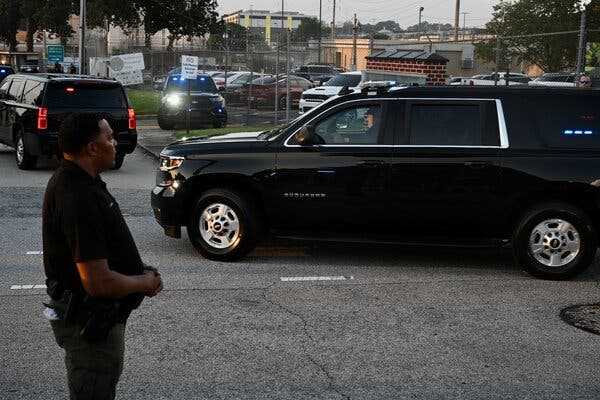The next step is the arraignment, which the Fulton County district attorney has asked the court to hold the week of Sept. 5.
- Share full article

The former president arrived in a motorcade and entered a rear entrance of the Fulton County Jail in Atlanta, to be booked on racketeering charges, on Thursday.
The booking of former President Donald J. Trump at the Fulton County Jail on Wednesday is only the start of a long legal battle, made more complex by the case’s large number of other defendants.
The next step is arraignment — a formal first appearance before a judge to be formally charged, set bail and enter a plea. The Fulton County district attorney, Fani T. Willis, has asked the court to hold the arraignments the week of Sept. 5.
Mr. Trump avoided having to wait in jail before appearing in court by negotiating a bail agreement in advance, and it is possible he will waive his right to appear at an arraignment.
In fact, all 19 people indicted in the case have the right to waive their arraignments. Doing so would avoid their having to return to Atlanta to appear in court, should the presiding judge, Scott McAfee, agree to such a plan.
The arraignment process is a starting bell, of sorts. The judge in the case will set a schedule for pretrial motions, which are expected to be plentiful. Defendants generally have 10 days after their arraignments to make pretrial motions, or requests for rulings they want the court to take before a trial.
Three defendants have already filed petitions to move the trial to federal court.
But even if the case remains in state court, one can expect other motions, such as ones to suppress certain evidence and perhaps to sever some of the defendants from the main case and try them separately.
In addition, before the trial starts, there will be copious amounts of evidence that must be turned over to the defense by the prosecution — a process known as discovery — which can take time, especially in white-collar cases involving lots of documents, phone records and security camera footage.
Defense lawyers may also see if there are grounds for what are known as demurrers, or requests to the court to dismiss the indictment. They can argue, for instance, that the indictment fails to include all the elements of the crimes charged, or that the grand jury was improperly composed.
All these motions take time to litigate, and with so many defendants, merely scheduling hearings and court dates will be difficult.
In what could be another wrinkle, some defendants might choose to plead guilty or even cooperate with the prosecution, and each of those decisions would be the result of negotiations with the Fulton County district attorney’s office.
At the same time, what is known as “a speedy trial clock” will be running. In Georgia, criminal defendants must be brought to trial within the second court term, after their arrest, though the court terms — the period of time a court is in session — vary from county to county, and delays are possible if all parties agree.
In Fulton County, where this case was filed, terms in the Superior Court are generally for two months, so to meet the state’s speedy trial law the trial would have to be held by Nov. 3.
Some of the defendants, for tactical reasons, may also make a formal demand for a speedy trial, hoping to pressure prosecutors and give them less time to prepare. One of Mr. Trump’s co-defendants, Kenneth Chesebro, has already done so.
On Thursday, Ms. Willis responded to Mr. Chesebro’s demand by asking the court to start the trial on Oct. 23.
A speedy trial would apply to all 19 people indicted in the case. But since some defendants are seeking to move the case to federal court or have said they will seek to sever their cases, the timing of any trial or trials is unclear. Mr. Trump filed a motion on Thursday afternoon saying that he would seek to have his case severed from Mr. Chesebro’s or from that of any other defendant who seeks a speedy trial.
James C. McKinley Jr., a senior editor on the Live team, has held a range of jobs at The New York Times, starting on Metro with the police beat and then City Hall. Later, he was a bureau chief in Nairobi, Houston and Albany, a correspondent in Mexico City, an investigative reporter in Sports and a pop music reporter in Culture. He returned to Metro to cover the Manhattan courts, and later became an assistant editor overseeing criminal justice reporters. More about James C. McKinley Jr.
- Share full article
SKIP ADVERTISEMENT
Source: nytimes.com



